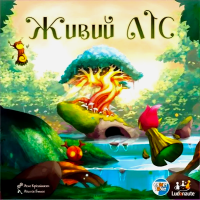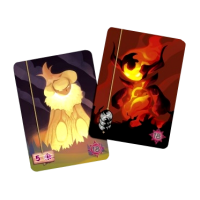Impressions of the game Living Forest
Related Products

REVIEW
1-4 players, 40 minutes
Designers: Aske Christiansen
Artist: Apollin Etienne
Publisher: Ludonaute
Publisher in Ukraine: Games7Days
OUR HISTORY
It's always interesting to know the winners of the Kennerspiel des Jahres and Spiel des Jahres, although the latter is awarded to lighter games that aren't always on our radar. Well, this year it was Living Forest that won the prestigious title of expert game of the year. Which, to be honest, was a bit surprising - considering its difficulty, Living Forest can't be classified as an expert game. But we've played this game quite a few times already and yes, we think it's really too easy for expert level. But we understood why she won the award and it was a great experience.
Thematically, Living Forest is set in an enchanted forest (obviously) - the game is inspired by Japanese mythology, though I'm not entirely sure how much. Players embody spirits trying to save the forest from the threat of the Onibi, which in Japanese folklore is represented as a ghost that often appears as fire: that's why you always need to put out the fires that the Onibi lights.
The design contributes to the thematic value of the game - the game looks extremely beautiful on the table, and the cards remind us of Medow (which is great). But that's where the similarities end, because we're dealing with completely different games. Living Forest has three win conditions: players must plant 12 different trees, collect 12 mystical flowers, or put out 12 fires. It's always the same number - 12. And that's great - it means we're dealing with a game that's very well balanced, but most importantly, it accurately defines the game's duration at around 45 minutes, which is perfect for this level of difficulty .

So, we already mentioned how balanced this game is - and it's true. No matter which path you choose, you have the same chance of winning if you play it right. Well, that's to be expected from a good game. And it's great that "Living Forest" lived up to... expectations. But let's dive deeper. Players cannot do without the help of forest inhabitants: animals depicted on the cards. Each player starts with the same set of cards, which is a strong indication that we are dealing with deck collecting. Thanks to the open draft, players will have the opportunity to attract new animals to their deck. It sounds simple - and it mostly is: the catch is that you really have to be careful which animals you recruit, as some don't get along so well with others. And that's because each card with animals shows several symbols (action in the game) - the more symbols of one species, the more powerful the action. We were a little afraid of this - it seemed that there was a lot of math waiting for us. But it turns out that's not the case - you just have to do some very simple additions and subtractions (some animals don't get along with others, remember?) to work out the total for each symbol.
You may be wondering exactly how this works, because at some point you have to stop drawing cards. Well, that's where the hermit animals come in - they're usually stronger (bringing more symbols into play and often with positive balance), but the catch is that you have to stop drawing cards from your deck once you get three lone animals out. Of course, there are animals that counteract their effects (you can think of them as yin and yang), so if you're careful enough, you can purchase them from the "market". So it's a "lucky" component of the game (and that's a good thing, it's one of our favorite mechanics - plus, it feels that way here). And it's important to note that you have a limited number of actions per turn - two (different) if you stop before bringing in three lone animals, and only one if you're forced to stop. So sometimes you can try your luck, but it's worth noting that this means you'll be doing 50% less actions that will end.

So there are three ways to win the game, but there are 4 possible actions: you can advance around the rondel, put out fires, hire new animals or plant trees. However, there is a fifth symbol on the cards (a mystical flower, but it is not an action in itself). Well, let's start with the pan - it's represented by the spiral symbol: advancing here can be crucial - not only does it allow you to perform a bonus action that you don't have enough power for (or just want to do it again), but it also allows you to take one a victory token from opponents you defeat (which brings you one stop closer to victory).
Additionally, there are sun symbols - these allow you to draw more animals into your deck - divided into three categories (of increasing value). It's possible to add more animals to your deck, but you also have to consider that Onibi lights a fire for every animal card drawn that round! This can be a good strategy to face your opponents, especially if they don't have enough power (symbols that add more than the total fire value) to put out these fires. And this brings us to the third action - symbols of water help extinguish fires. Once you reach 12 fires, you win (well, almost - but we'll talk about that). This is probably the most interesting part of the game, as it has a semi-cooperative aspect: if players don't have enough water to put out the fire, they have to draw Fire Dragons (Onibi creatures) into their deck. And they don't idle: aside from being lonely, they offer absolutely nothing in return, so you don't want them around when you draw cards. By the way, it's nice that the game offers fragment tokens as a means of discarding unnecessary cards.
Last but not least, trees - every player starts with the same empty display. This is the place where the magic trees will be planted - this is the tile placement component. Each individual tree counts towards the win condition. Clever placement can also trigger some valuable bonuses (for completed lines and columns and closed corners) - there are only two bonus actions available (compared to the pan, which has many more options), but they are more powerful. Yes, strategy also plays a big role here. It's also worth noting that there are only a limited number of trees of each species available - buying more trees of the same species gives you double the benefits and disrupts your opponents' plans, even if you're nowhere near the 12 different trees you need. .

It's amazing how grounded the actions are - they influence each other and work together. So it's impossible to focus on one thing because you need a lot more to win. Take flowers for example - of course you can just buy animals with flower symbols. Of course you could, but you need more fire symbols to buy more powerful animals, and you also need flowers from other sources (like trees) because you can't just rely on the luck of the draw. Game mechanics form a well-oiled engine, and it shows. The simplicity of the action makes the game accessible to everyone (and makes it perfect for family game nights), but the difficulty lies in how you link and time your actions so that you can collect the right items before others.
And last but not least, yes, it's the difficulty of the game that made it feel a little bland to us after a few plays. Of course, it's still pretty relaxing and we'd be happy to play it anytime. But once you get the hang of the puzzle, the action starts to feel a little too easy - I'm sure more players open up many more possibilities. Finally, the Living Forest remains an absolute gem for the money (you can find it for as little as €25-30) - maybe we'll even introduce it to our parents one day...


